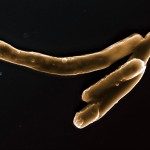Link to Pubmed [PMID] – 12368436
Microbiology (Reading, Engl.) 2002 Oct;148(Pt 10):3029-37
Mycobacterium tuberculosis encodes two-component signal systems. Recently, it was established that the viability of the M. tuberculosis phoP mutant is attenuated in the mouse, suggesting the requirement of the phoP gene for M. tuberculosis intracellular growth. It is now largely acknowledged that M. tuberculosis mannosylated lipoarabinomannans (ManLAM) play a key role in M. tuberculosis intramacrophagic survival by altering the macrophage functions. So ManLAM were extracted and purified from the M. tuberculosis MT103 wild-type strain and from the M. tuberculosis phoP mutant. Their two major functional domains (i) the mannooligosaccharide caps and (ii) the mannosyl phosphatidylinositol anchor were here investigated. Using capillary electrophoresis, it is demonstrated that both mutant and wild-type M. tuberculosis strains share the same capping motifs: mono-, di- and trimannosyl alpha(1–>2) units, with the same relative abundance. Using two-dimensional NMR spectroscopy, the same acyl forms were found to be shared by both strains. However, their relative abundance was quite different. Indeed, in the phoP mutant a decrease of the triacylated ManLAM and an increase of the monoacylated ManLAM were observed. The difference in the proportion of ManLAM acyl forms and the reduced virulence of the M. tuberculosis phoP mutant are discussed.

